For the betterment of the breed.

There is a wealth of knowledge within the club and sharing this knowledge is an important aspect of promoting and protecting the Samoyed. Assisting with lost Samoyeds and finding those in need a new home is also an important activity of the club.
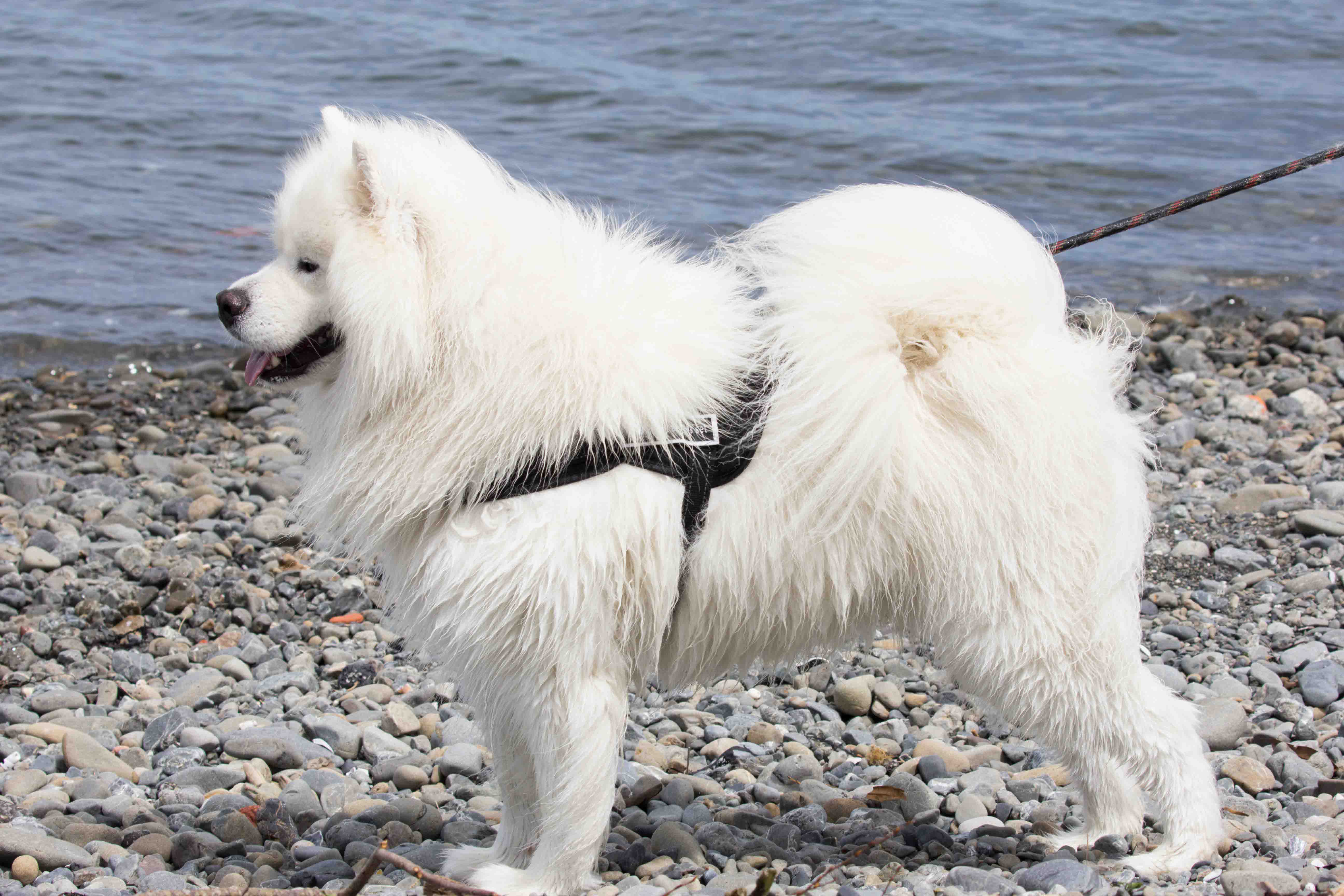
TIPS ON SAMOYED CARE
There are many useful books, articles and video clips that can be purchased or googled on the internet. Your Veterinarian will also be an important person in helping you keep you Samoyed healthy.
The following articles were supplied by respected breeders:
Puppy feeding guide
My aim at Skrownek since breeding my first litter in 1977 has been to produce typical, healthy and beautiful Samoyeds that bring their owners years of pleasure.
The puppy diet outlined here is well proven over many generations now and stresses natural and unprocessed food - mainly raw meat and raw bones, cereal and biscuits, raw veges, milk products and eggs.
The best book I have found on feeding dogs is Give Your Dog a Bone by Sydney veterinarian Ian Billinghurst and I recommend you obtain a copy and follow its recommendations.
While you can feed cooked meat, tinned dog food or dog roll, a dog’s jaws and digestive system are designed superbly for natural canine tucker of raw meat and bones. If you choose to change your puppy’s diet, do it gradually to avoid stomach upset.
The emphasis in feeding your growing puppy must always be on top quality food - your Samoyed will reach its full adult height by seven months of age so those early months in your care are crucial.
The Skrownek Samoyed feeding diet is based on the following foods:
Animal Products
- Raw meaty bones from chicken, lamb, beef, rabbit, pork
- Muscle meat from chicken, lamb, beef, pork
- Organ meat - liver, kidneys, hearts
- Eggs, especially yolk, and including the crushed shell. About 3-4 eggs a week.
- Milk, yoghurt, cottage cheese
- Seafoods - fatty fish, mackerel, sardines
Plant Products
- Fresh, green leafy vegetables, spinach, silverbeet, broccoli, asparagus
- Corn, kumara, pumpkin
- Whole grains - rolled oats, brown rice, wheat germ, bran, wholemeal bread
Miscellaneous
- Brewers yeast, kelp, apple cider vinegar
Oils
- Corn, sunflower, peanut, wheatgerm oil
From this list you can devise a diet for dogs that will make and keep any dog healthy, active, fertile and long lived.
I quote the Ten Secrets of Successful Puppy Rearing from Ian Billinghurst’s book:
- Heaps of raw meaty bones as the basis and major component of the diet - about 60 per cent of total food intake.
- Grow puppies slowly, keeping them lean and slightly hungry.
- Feed a wide variety of foods.
- Feed mostly raw foods.
- Feed food suitable for growth – foods high in good quality protein, fats, vitamins and minerals.
- Do not base the puppy diet on raw steak, commercial dog food or calcium supplements.
- The only exercise allowed is play.
- Pups must spend most of their time in fresh air on clean earth and grass in the sun, with ample supply of fresh water available.
- The diet is balanced over time, not by providing balance in every meal.
- Your puppy is raised with love, resulting in a strong immune system and a puppy that is watched and fed according to its weight, condition and general health.
Typical feeding day for a Eight-week-old puppy
Early Morning
A milk drink – goat’s milk is great if you can get it otherwise cows. One tsp or so of raw organic honey, mixed with a couple of tablespoons of acidophillus and bifidus yoghurt (organic if possible) – goat’s milk yoghurt is great - egg yolk and crushed egg shell, one tsp oil and make up to half a pint to a pint or so, increasing quantities as pup grows.
Lunch
Cereal and veges.
Rolled oats, uncooked, soaked overnight in milk, yoghurt, 50:50 milk-water. With some cooked brown rice, with egg and crushed shell, tsp of oil, pinch of seaweed powder, dash of apple cider vinegar, tsp of brewers yeast. Couple tablespoons of raw, pureed veges with juice. Cooked vege table scraps can be added but make at least half the veges raw.
Cottage cheese. Dried fruit.
Or dog biscuits - commercial or home made. To start puppies on biscuits, soak them slightly in warm water until they can cope with them whole. If feeding little puppy biscuits, watch they don’t gulp them down and choke. About a cupful or so of cereal mix.
Afternoon
Raw meat and bones. Beef, lamb, chicken etc with fat included. Feed in biggish chunks, eventually giving meat and bones or meat on the bone in one lump. Puppies should eat the bones, so you may have to smash them up a bit especially chicken. Cheap boiling fowls are good once the pup is a bit bigger. Thaw out thoroughly if frozen and give the whole bird.
Chicken frames are good too. Sheep meat must be frozen for a week before thawing and feeding. Economical cuts are lamb necks and flaps. Economical beef cuts are ox cheeks and brisket bones are excellent. Rabbit, skin and all, is great if you hunt or have hunting friends. About 200-300 grams.
Offal should be fed reguarly – chicken hearts and livers can be fed raw, but sheep and beef offal needs cooking according to New Zealand law. A small quantity, say 100 grams, grated into cereal with juice, or with meat, weekly.
Evening
Raw meat on the bone again – about 200–300 grams.
At about four months of age, or sooner if need be, cut out the afternoon meat feed and give all the meat in one feed at night. Note that while cereal, dairy products, veges and fruit are an integral part of the dog’s diet, at least 60 per cent must be raw meat on the bone (or with bones).
Note: when the diet talks about raw meaty bones, this is better understood as meat on the bone or meat and bones.
Your puppy reaches full height at about seven months, but does not reach full maturity until about three to four years of age. Weight at maturity is usually about 25kgs for bitches, 30kg for dogs. A good diet along the above guidelines is essential if your puppy is to grow to true adult beauty.
At about 12 months your pup will probably be eating about 600 grams of food a day in two meals – cereal mix/biscuits at lunch or morning, meat on the bone at night. Quantities will vary depending on your pup’s mood. Do not worry if your pup goes off its tucker, they will eat when hungry.
Your puppy should be lean with backbone and ribs covered but easily felt.
To blossom into healthy, happy adulthood your Sammie pup relies on you for good food and care.
Sandra Stewart
Skrownek Stud
Reference:
Give Your Dog a Bone– Dr Ian Billinghurst
Published by Direct Book Service, Feb 2000
https://www.drianbillinghurst.com Give Your Dog a Bone - Dr Ian Billinghurst
Introduction to Grooming
The first thing people say when they see a Samoyed is "what a beautiful dog" followed quickly with "Oh they must be so hard to keep clean". I have never found it difficult to keep my Samoyeds clean and as long as you regularly groom them they will stay pretty good until one day you just know it is time for a bath. Of course if you are showing your Samoyed you will be bathing before a show.
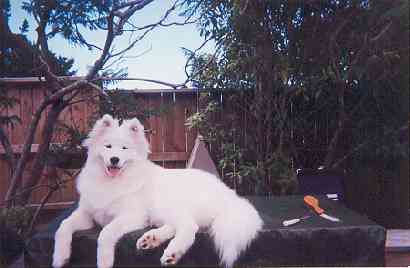
Katie. Puppy and grooming tools.
Teaching your dogs to enjoy been groomed is so important and there is nothing worse than having a struggle with a puppy or a full grown dog that wants his own way. If breeders start handling the babies when in the nest they will find how quickly these little guys will scramble for that attention.
You do have to teach your dog manners for grooming and they will learn very quickly who is the boss and who they can take advantage of. Just remember if they object to an area been done, do not move onto another area because you have set a pattern that will be hard to break. With little ones don’t expect them to lie still at the beginning for the entire groom. Do one side of them, then let them free for a play then continue with the other side.
Grooming should be a pleasure for you and a pleasure for your dog and they will quickly learn where the grooming gear is kept and there will be a rush to the grooming table to be first served. For those first lessons on the table give the puppy a pig ear or a chewy teat to occupy him and to distract him but he must still learn from you that you expect him to stay still.
As well as the usual "sit", "down" and "stay", teach him commands such as "turn around", "the other side" or "let’s do your tummy". By talking to your dog while grooming and bathing him you will be amazed just how cooperative they become when they remember the words. "the other side" or "let’s do your tummy".
Grooming a Samoyed is not hard and a thorough combing at least every two weeks (more when they are moulting) and a brush twice a week will keep your Sam looking very nice. If you want to brush them everyday, do so, but it is not necessary.
The purpose of grooming is to remove dead and loose coat, to prevent matting and to stimulate new hair growth. It is a chance to inspect your Sam for any health issue, to inspect the skin for lumps, especially in the older dog, check for grass seeds and for fleas, ticks (Frontline should be used to prevent the last two).
Inspect the ears and remove any wax build up with cottonwool, check teeth for tartar and clip nails. It is an opportunity to spend individual time with your dog and they really love that.
The brushing of your dog’s coat is done the way as combing and that is by layers and then a vigorous brushing from tail to head. If your Samoyed should get a bit grubby and you don’t want to bath him, a quick dry-clean is achieved with towels rung out in a bucket or tub of hot water in which a small quantity of dish liquid has been added and the towels rubbed over the coat. Rinse and repeat several times and you will find the surface dirt will disappear.
This is also a good tip to refresh coats between shows and the hot towels will give a look of volume to the coat. A Chamoi wiped over the coat is also a good method to pick up dead loose hairs.
Grooming Tools:
Good grooming equipment is paramount and everyone will have their favourite combs and brushes. I do prefer combs with handles as they are easier on the hands but I was given a set of three combs back in 1973 and I still have them and they still give me the best results. These combs are English made by Hinders Ltd and are three different teeth widths. The wide spaced teeth I would use for the first grooming on the ruff and trousers and tail of a male coat. The second sized spaced teeth is for the main all over body groom and the very close teeth for the face and legs and feet. I would never use the very fine comb on trousers, tails or ruff on a male coat but you can use them on a female coat for the final groom apart from the tail.
I have about five combs of different sizes. You need a metal pin brush set in a rubber backing and these come in different length pins, so naturally for a long coat you would use a longer pin brush or else it could tangle in the coat and on a bitch the shorter length pins will be perfect.
It is important that when you brush that the bristles will reach the skin. Some of the brushes have small plastic caps on the metal tips but I have found they come off leaving a very sharp pointed tip. Before you buy any brush or comb try it on your own hair, if the teeth don’t dig into your scalp and it feels smooth as you pull it through your own hair, it will be perfect for your Samoyed. The ends of the teeth should be rounded and smooth. A nylon brush is wonderful to create static electricity for the last brush and these can be bought from a pharmacy as well as a Pet Supplier.
The only other brush I own is a rake. This is a flat square thin backed brush with short metal bent pins. The ONLY time you should use this is when your dog is loosing coat, it will help to get the loose hair out but do not use it at any other time as it will tear the hair.
Spend the best money you can on quality grooming gear, have your name engraved on them and guard them with your life. Do not forget to wash your brushes and combs out regularly (as well as leads) and dry them thoroughly.
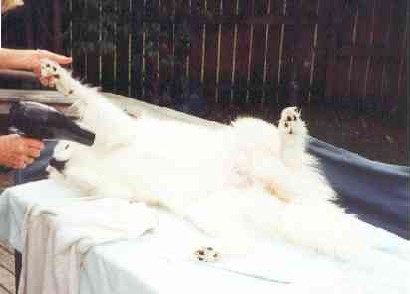
Katie enjoying drying.
We are not discussing bathing but a beautifully presented Samoyed is only as good as the groom prior to the bath and the quality of the bathing. I also blow dry my dogs, dry and as they near to drying I start to work with the brush so when they are dry they could be shown.
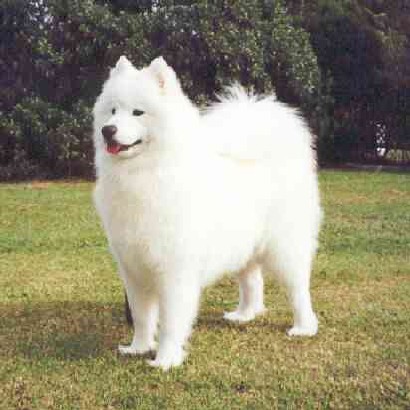
Katie blow dried but not groomed.
The Groom:
Now we start with the groom and it is so much easier for your back if you have your dog at waist height so a table is perfect. Crates can have a wooden piece of ply fitted into the top and this will be excellent also. Just cover them with a non-slip blanket.
I don’t really think there is any set way of where you should start but it is a good idea if your dog has a part of his body that he is sensitive about that you get this done first. It is a good idea to divide your dog into sections, the forequarters, the neck head and front. The middle section of tummy, sides and back, then the hind quarters and tail. I like to start with my dog lying on its side and I either start at the front leg at the foot and work my way up to the shoulder or start at the back foot and work up to the thigh.
Wherever you start, set a pattern in your mind so that you work from one area to another or move to another area and work back to what you have done. A Samoyed has many different directions of coat growth and different coat length and thickness so move through your combs accordingly.
I always think it is easier to demonstrate grooming than it is to describe it but here goes. The object of the exercise is to comb every hair on your dogs body and I mean every hair, layer by layer from the skin to the ends of the coat, by parting the hair with the left hand and putting the comb, held in the right hand, to the skin and combing the hair out to the ends of the coat.
The left hand is placed firmly on the hair above the area which you are grooming so the skin is not pulled. You gradually work through each section as detailed above, combing every section of hair so that if the comb were pulled through the coat it would slide freely without tugging or catching.
So many people do not comb to the skin and have an ungroomed layer, if you do this your dog will never look good. Also if your dog starts to drop coat, please don’t think you can get away with showing him without grooming to hold his coat, he will also never look good.
To detail some of the difficult areas we will start with the face and with a very fine comb, comb the muzzle and up through the forehead and between the eyes and the skull. Comb the hair behind the ears and inside the ears and the short coat that is the outline of the ear. Comb the short hair framing the face before it goes into length.
Under the chin and mouth is an area often neglected and if your dog will lie on his back and drop his head back you will be able to comb it easily. If not, get your dog to sit and with the back of your left hand hold his head up with nose pointing to the sky and you will be able to comb it easily. Leg featherings are combed in the direction they grow, in layers and don’t forget the elbows. Leg hair is combed with a fine comb.
Don’t neglect the tummy and again a dog that will lie on its back allows you to comb the inside of the thighs but don’t pull this area as it is very sensitive and be mindful of the private parts of both sexes. While they are still on their back, work your way up the chest and under the arms. Hock featherings are so often neglected and a fine comb is used.
When you do the legs remember they have an inside as well as an outside. Trousers need a bit of care and I stand behind my dog at the tail end and with the dog lying on its side I push all the hair away from me towards the dogs head and start combing the very bottom layer and working through each layer until the trousers are back where they belong.
Don’t forget the short hair just under the base of tail, another sign of a less than perfectly groomed Samoyed. Now to the tail.
Most Sams hate their tails been groomed and I find it easier to take the tip of the tail between my fingers and form a small pom pom at the end and with the brush work through that hair. I then slide my hand down the tail by another inch and make a bigger pom pom and including the groomed hair proceed to brush the hair away again towards the tip of the tail. I work my way down to the base of the tail, section by section, until you are holding this glorious plumed tail. Give it more brushing from base to tip then take the tip of tail in your fingers and give the tail a shake and every hair will fall into place.
Don’t forget the fine hair between the toes and between the pads and when you are satisfied every hair is groomed and this can take two or three groomings and I can’t emphasize this enough then brush and brush and brush from under the tail to head, along the sides and up the chest to the head and then blow gently on your dog and tell him to shake (teach this little trick) and every piece of hair will fall into place presenting a beautiful picture.
Check your dogs eyes for matter and wipe clean and wipe any dribble away from his lips, a little bit of Vaseline on his nose to be a perfectionist and away you go.
Good grooming and remember your dog will only look as good as the effort you put in.
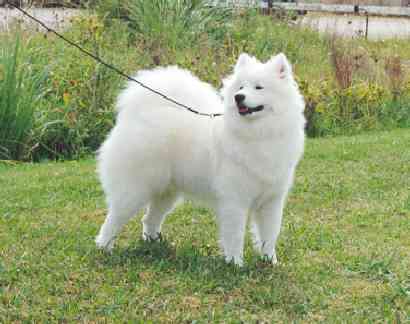
Katie ready for her show.
Judi McCormick
Silvertips Samoyeds
New Zealand Kennel Club Supplement May 2006
How to Train a Samoyed
Samoyeds are working dogs that originated in Russia. These dogs are bred today to herd, pull sleds, and as watch dogs for homes and families. A Samoyed is characterized by a long, luxurious coat that is generally white, yellow, or cream in color. These are bright, energetic, and hardy dogs that must be trained from an early age to ensure they do not let their naturally precocious natures get the best of them. Have a question? Get an answer from a Vet now!
- Start at a very early age. Samoyeds, or Sammys, are highly intelligent animals who respond well to consistency and firmness.
- Take the role of the alpha, or pack leader, right away. For instance, if you do not want your Samoyed on the furniture, make sure to consistently never allow him to lay on the couch or your bed, or else the dog will see itself as higher in the pack than you, and will not respond to your authority.
- Give your Samoyed a job. Samoyeds are working dogs and can become bored and restless if left with no activity. Jobs for your Samoyed could include pulling a cart or a sled. This activity will give the dog self-confidence, which will aid in his overall health.
- Exercise your Samoyed daily. These are very high energy dogs that will channel any unused energy into naughty behavior, such as chewing.
- Give any verbal commands, such as sit, stay, or lie down, with an enthusiastic and happy tone.
- Praise your Samoyed after correctly performing a task. These dogs crave attention from their owners and will respond well to verbal praise.
- Offer your dog words of correction such as "no" and "enough" with a firm, low tone if the dog exhibits unacceptable behavior, such as biting, nipping, or unnecessary barking. It is important that your Samoyed understands the different tones used for good and bad behavior.
Jaimie Zinski
Demand Media
